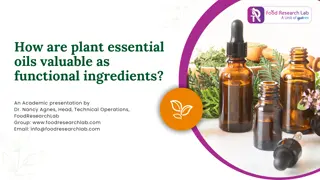Innovations in Non-Thermal Food Processing Techniques
Non-thermal processing methods have emerged as a solution to the limitations of thermal food processing, offering benefits such as better retention of volatile compounds, nutrients, and flavors. This article explores various non-thermal techniques like Ohmic Heating, Microwave Heating, Pulsed Electric Field Technology, and more, highlighting their mechanisms and advantages in food preservation. These methods are particularly important for large-scale food production due to their efficiency and quality preservation capabilities.
Download Presentation

Please find below an Image/Link to download the presentation.
The content on the website is provided AS IS for your information and personal use only. It may not be sold, licensed, or shared on other websites without obtaining consent from the author. Download presentation by click this link. If you encounter any issues during the download, it is possible that the publisher has removed the file from their server.
E N D
Presentation Transcript
Why Nonthermal? The main problem with the thermal processing of food is loss of volatile compounds, nutrients,and flavour. To overcome these problems non thermal methods came into food industries to increase the production rate and profit. The non thermal processing is used for all foods for its better quality , acceptance, and for its shelflife. The new processing techniques are mostly employed to the liquid packed foods when compared to solidfoods.
Since the non thermal methods are used for bulk quantities of foods, these methods of food preservation are mainly used in the large scaleproduction. The cost of equipments used in the non thermal processing is high when compared to equipments used in thermalprocessing. After minimising the investment costs of non thermal processing methods, it can also be employed in small scale industries.
NON-THERMAL PROCESS ARE:- Ohmic Heating Microwave heating Radiofrequency heating Infrared heating High Pressure Processing Pulsed Electric Field Ultrasonics Pulsed Light Technology Pulsed X-rays Irradiation Oscillating Magnetic Field
Microwave Heating: Refers to the use of electromagnetic waves of certainfrequencies(2450MHzand915MHz.)to generateheatinmaterial. Container with food is placed in a microwave oven And then a oven is activated, the food at the edge of the container heats faster and a temperature gradient develops between the centre and the edges
Mechanism Dipolar interaction: polar molecules such as water molecules(dipole) inside the food will rotate according to the alternating electromagneticfield. The rotation of water molecules would generate heat forcooking Ionic interaction: Ionic compounds (i.e. dissolved salts) in food can also be accelerated by the electromagnetic field and collided with other molecules to produce heat
PULSED ELECTRIC FIELD (PEF) TECHNOLOGY PEF is a non-thermal food preservation technology that involves the discharge of high voltage electric pulses (up to 70 kV/cm) into the food product, which is placed between two electrodes for a fewmicrosec
HIGH PRESSURE PROCESSING: (HPP) High Pressure Processing is also known as High Hydrostatic Pressure or Ultra High Pressure processing. HPP uses up to 900MPa to kill many of the micro organisms found in foods, even at room temperature without degrading vitamins, flavor and colour molecules in the process. Food packages are loaded onto the vessel and the top is closed. The pressure medium usually water is pumped into the vessel from thebottom.
Oncethedesiredpressureisreached,thepumpingis stopped,valvesareclosed, pressurecanbemaintained withoutfurtherneedforenergyinput. Principle: A principle underlying HPP is that the high pressure is applied in an isostatic manner such that all regions of food experience a uniform pressure, unlike heat processing where temperature gradients areestablished.
PULSED LIGHT (OR) HIGH INTENSITY LIGHT TECHNOLOGY : High Intensity Light Technology can be used for the rapid inactivation of micro organisms on food surfaces, equipments and food packagingmaterials. High intensity white light and UV light food preservation methods employ light wave lengths ranging from ultra violet to near infra-red in short intensepulse. Pulses of light used for food processing applications typically emit one to twenty flashes per second of electromagneticenergy
It is generally accepted that UV plays a critical role in microbialinactivation. The treatment is most effective on smooth, nonreflecting surfaces or in liquids that are free of suspended particulates. In surface treatments, rough surfaces hinder inactivation due to cellhiding.
Ohmic heating Ohmic heating is an advanced terminal processing method where in the food material which serves as an electrical resistor, is heated by passing electricity through Which result in rapid & uniform heating Electrical resistance heating or joule heating or electro-heating 13
Important benefits Fast Processing 1. Homogeneous Treatment 2. More effective method 3. 14























